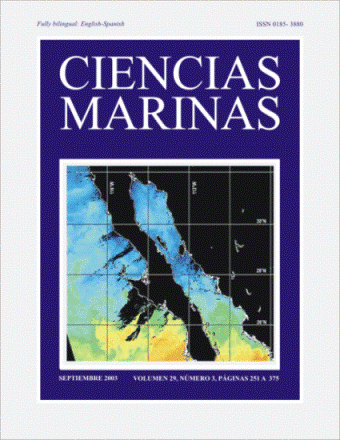Microhabitat and associated biota of abalone juveniles, Haliotis fulgens and H. corrugata, in Bahía Tortugas, Baja California Sur, Mexico
Main Article Content
Abstract
Abalone is an important economical resource on the west coast of Baja California. The most important species in this fishery are green and pink abalone (Haliotis fulgens and H. corrugata, respectively). Overfishing has been implicated in the decline of the Mexican abalone fishery. Among the population parameters, recruitment is a highly variable event. To obtain a better understanding of the ecology of abalone juvenile recruitment, the physical and biological characteristics of the microhabitat of juveniles of green and pink abalone were studied at Bahía Tortugas, Baja California Sur (Mexico), during autumn and spring from 1996 to 1998. Two abalone reefs with different depth, relief and wave exposure were surveyed: Clam Bay, with depths of 0.5 to 5 m, and Morro de Adentro, with depths of 6 to 12 m. Four different bottom types were recognized: (a) sheltered and low relief bottom, (b) semiexposed and moderate relief bottom, (c) exposed and high relief bottom, and (d) exposed and moderate relief bottom. Juveniles of green and pink abalone from 3 to 13 mm shell length were observed under small rocks, pebbles and flat stones no longer than 15|00E2|??20 cm, always covered with crusts of coralline algae. Several tiny juveniles of Fisurella, Stenoplax, and Crepipatella of similar sizes (5–10 mm) shared the microhabitat. Juveniles between 15 and 90 mm shell length were found under flat, rhombic or irregular-shaped rocks (20–110 mm length), most of them deployed in imbricate arrangement. Abalone juveniles shared this microhabitat with bryozoans, sponges, ascidians, chitons, and annelids. Bottoms with imbricate arrangement, low wave exposure, and the low depth of Clam Bay were favorable for the high occurrence of juveniles of H. fulgens. Juveniles of H. corrugata showed a high occurrence in exposed and deeper zones of Morro de Adentro.
Downloads
Article Details
This is an open access article distributed under a Creative Commons Attribution 4.0 License, which allows you to share and adapt the work, as long as you give appropriate credit to the original author(s) and the source, provide a link to the Creative Commons license, and indicate if changes were made. Figures, tables and other elements in the article are included in the article’s CC BY 4.0 license, unless otherwise indicated. The journal title is protected by copyrights and not subject to this license. Full license deed can be viewed here.

